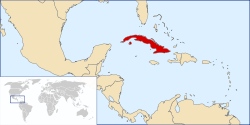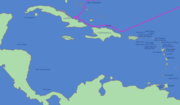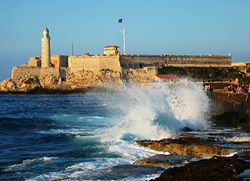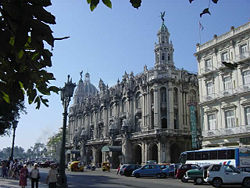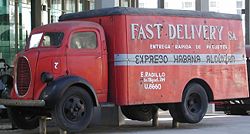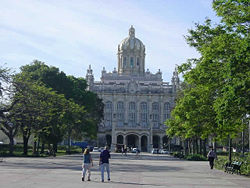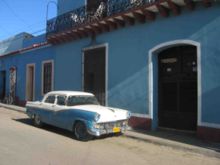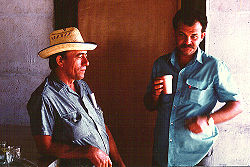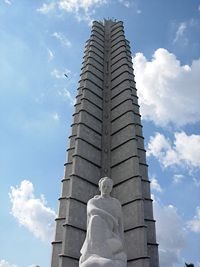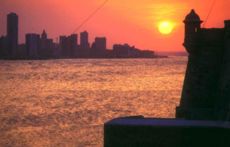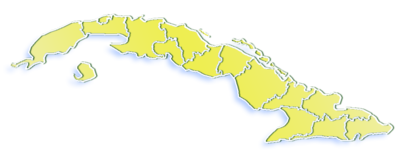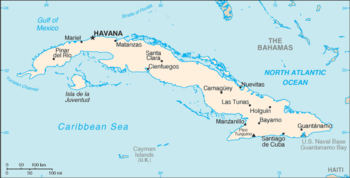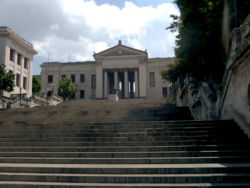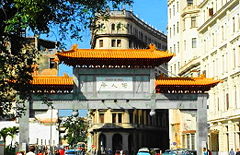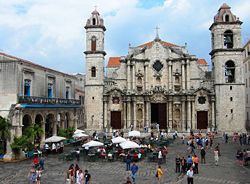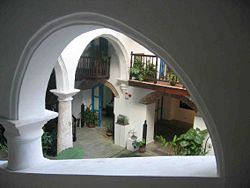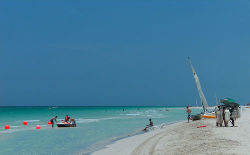Cuba
2008/9 Schools Wikipedia Selection. Related subjects: Americas; Countries
| República de Cuba Republic of Cuba
|
||||||
|---|---|---|---|---|---|---|
|
||||||
| Motto: Patria o Muerte (Spanish) "Fatherland or Death" |
||||||
| Anthem: La Bayamesa ("The Bayamo Song") |
||||||
|
|
||||||
| Capital (and largest city) |
Havana |
|||||
| Official languages | Spanish | |||||
| Ethnic groups | Spanish, French, Black, Taíno | |||||
| Demonym | Cuban | |||||
| Government | Socialist Republicb | |||||
| - | President of the Council of State | Fidel Castro | ||||
| - | Acting President of the Council of State | Raúl Castro | ||||
| Independence | from Spain | |||||
| - | Declaredc | October 10, 1868 | ||||
| - | Republic declared | May 20, 1902 | ||||
| - | Cuban Revolution | January 1, 1959 | ||||
| Area | ||||||
| - | Total | 110,861 km² ( 105th) 42,803 sq mi |
||||
| - | Water (%) | negligible | ||||
| Population | ||||||
| - | 2006 estimate | 11,382,820 ( 73rd) | ||||
| - | 2002 census | 11,177,743 | ||||
| - | Density | 102/km² ( 97th) 264/sq mi |
||||
| GDP ( PPP) | 2006 estimate | |||||
| - | Total | $46.22 billion (2006 est.) ( not ranked) | ||||
| - | Per capita | $4,500 (2007 est.) ( not ranked) | ||||
| HDI (2007) | 0.838 (high) ( 51st ) | |||||
| Currency | Cuban Peso ( CUP)Convertible peso d ( CUC) |
|||||
| Time zone | EST ( UTC-5) | |||||
| - | Summer ( DST) | (Starts March 11; ends November 4) ( UTC-4) | ||||
| Internet TLD | .cu | |||||
| Calling code | +53 | |||||
| a As shown on the obverse of the 1992 coin (Note that the Spanish words "Ka Patria" feminine in Spanish is translated into English as either "Cradle" or "Place of Birth" or "Homeland.") b states that "Cuba is an independent and sovereign socialist state [Article 1]... the name of the Cuban state is Republic of Cuba [Article 2]." The usage "socialist republic" to describe the style of government of Cuba is nearly uniform, though forms of government have no universally agreed typology. For example, Atlapedia describes it as "Unitary Socialist Republic"; Encyclopædia Britannica omits the word "unitary," as do most sources. c At the start of the Ten Years' War. d From 1993 to 2004, the U.S. dollar was used in addition to the peso until the dollar was replaced by the convertible peso. |
||||||
The Republic of Cuba (Spanish: Cuba or República de Cuba [re'puβlika ðe ˈkuβa]), consists of the island of Cuba (the largest and second-most populous island of the Greater Antilles), Isla de la Juventud and several adjacent small islands. Cuba is located in the northern Caribbean at the confluence of the Caribbean Sea, the Gulf of Mexico and the Atlantic Ocean. Cuba is south of the eastern United States and The Bahamas, west of the Turks and Caicos Islands and Haiti and east of Mexico. The Cayman Islands and Jamaica are to the south. The national flower is Hedychium Coronarium Koenig, most known as "mariposa" (butterfly) and the national bird is "Tocororo" or "Cuban Trogon" from the family of Trogonidae.
Cuba is the most populous nation in the Caribbean. Its people, culture and customs draw from several sources including the aboriginal Taíno and Ciboney peoples, the period of Spanish colonialism, the introduction of African slaves, and its proximity to the United States. The island has a tropical climate that is moderated by the surrounding waters; however, the warm temperatures of the Caribbean Sea and the fact that the island of Cuba sits across the access to the Gulf of Mexico make Cuba prone to frequent hurricanes. Cuba's main island, at 766 miles long (1,232.5 km), is the world's 17th largest.
History
The recorded history of Cuba began on 12 October 1492, discovered when Christopher Columbus sighted the island during his first voyage of discovery and claimed it for Spain. Columbus named the island Isla Juana in reference to Prince Juan, the heir apparent. The island had been inhabited by Native American peoples known as the Taíno and Ciboney whose ancestors had come from South America and possibly North and Central America in a complex series of migrations at least several centuries before, and perhaps 6,000 to 8,000 years ago. The Taíno were farmers and the Ciboney (far more commonly written Siboney in neo-Taino nations) were both farmers and hunter-gatherers; some have suggested that copper trade was significant and mainland artifacts have been found in proximal Taíno cultures.
The coast of Cuba was fully mapped by Sebastián de Ocampo in 1511, and in that year the first Spanish settlement was founded by Diego Velázquez de Cuéllar at Baracoa. Other towns including the future capital of the island San Cristobal de la Habana (founded in 1515) soon followed. The Spanish, as they did throughout the Americas, oppressed and enslaved the approximately 100,000 indigenous people that resisted conversion to Christianity on the island. Within a century they had all but disappeared as a distinct nation as a result of the combined effects of European-introduced disease, forced labor and other mistreatment, though aspects of the region's aboriginal heritage has survived in part via the rise of a significant Mestizo population. With destruction of aboriginal society, the settlers began to exploit African slaves, with more resistance to the diseases from the Old World, and who soon made up a significant proportion of the inhabitants.
Colonial Cuba
Cuba was in Spanish possession for almost 400 years (circa 1511-1898). Its economy was based on plantation agriculture, mining and the export of sugar, coffee and tobacco to Europe and later to North America. Havana was seized by the British in 1762, but restored to Spain the following year. The Spanish population was boosted by settlers leaving Haiti when that territory was ceded to France. As in other parts of the Spanish Empire, the small land-owning elite of Spanish-descended settlers held social and economic power, supported by a population of Spaniards born on the island and called Criollos by the Iberian born Spaniards, other Europeans and African-descended slaves.
In the 1820s, when the other parts of Spain’s empire in Latin America rebelled and formed independent states, Cuba remained loyal, although there was some agitation for independence. Due to its loyalty to the Spanish government, the Spanish Crown gave the following mottoe to the island government "La Siempre Fidelisima Isla" (The Always Faithful Island) This was partly because the prosperity of the Cuban settlers depended on trade with Europe, partly through fears of a slave rebellion (as had happened in Haiti) if the Spanish withdrew, and partly because the Cubans feared the rising power of the United States more than they disliked Spanish rule.
An additional factor was the continuous migration of Spaniards to Cuba from all social strata, a demographic trend that had ceased in other Spanish possessions decades before and which contributed to the slow development of a Cuban national identity. Pirates were also still a problem and defense against them depended heavily on the presence of Spanish troops.
Cuba’s proximity to the U.S. has been a powerful influence on its history. Throughout the 19th century, Southern politicians in the U.S. plotted the island’s annexation as a means of strengthening the pro-slavery forces in the U.S., and there was usually a party in Cuba which supported such a policy. In 1848, a pro-annexations rebellion was defeated and there were several attempts by annexationist forces to invade the island from Florida. There were also regular proposals in the U.S. to buy Cuba from Spain. During the summer of 1848, President James K. Polk quietly authorized his ambassador to Spain, Romulus Mitchell Saunders, to negotiate the purchase of Cuba and offer Spain up to $100 million. While an astonishing sum of money at the time for one territory, trade in sugar and molasses from Cuba exceeded $18,000,000 in 1838 alone. Spain, however, refused to consider ceding one of its last possessions in the Americas.
After the American Civil War apparently ended the threat of pro-slavery annexation, agitation for Cuban independence from Spain revived, leading to a rebellion in 1868 led by Carlos Manuel de Céspedes, a wealthy lawyer landowner from Oriente province who freed his slaves, proclaimed a war and was named President of the Cuban Republic-in-arms. This resulted in a prolonged conflict known as the Ten Years' War between pro-independence forces and the Spanish Army, allied with local supporters. There was much sympathy in the U.S. for the independence cause, but the U.S. declined to intervene militarily or to even recognize the legitimacy of the Cuban government in arms, despite the fact that many European and Latin American nations had done so. In 1878, the Pact of Zanjón ended the conflict, with Spain promising greater autonomy to Cuba.
The island was exhausted after this long conflict and pro-independence agitation temporarily died down. There was also a prevalent fear that if the Spanish withdrew or if there was further civil strife, the increasingly expansionist U.S. would step in and annex the island. In 1879-1880, Cuban patriot Calixto Garcia attempted to start another war, known in Cuban history as the Little War but received little support. Partly in response to U.S. pressure, slavery was abolished in 1886, although the African-descended minority remained socially and economically oppressed, despite formal civic equality granted in 1893. During this period, the rural poverty in Spain provoked by the Spanish Revolution of 1868 and its aftermath led to an even greater Spanish emigration to Cuba.
During the 1890s, pro-independence agitation revived, fueled by resentment of the restrictions imposed on Cuban trade by Spain and hostility to Spain’s increasingly oppressive and incompetent administration of Cuba. Few of the promises for economic reform made by the Spanish government in the Pact of Zanjon were kept. In April 1895, a new war was declared, led by the writer and poet José Martí who had organized the war over a ten year period while in exile in the U.S. and proclaimed Cuba an independent republic — Martí was killed at Dos Rios shortly after landing in Cuba with the eastern expeditionary force. His death immortalized him and he has become Cuba’s undisputed national hero.
The Spanish armed forces totaled about 200,000 troops against a much smaller rebel army which relied mostly on guerilla and sabotage tactics to fight battles, and the Spaniards retaliated with a campaign of suppression. General Valeriano Weyler was appointed military governor of Cuba, and as a repressive measure he herded the rural population into what he called reconcentrados, described by international observers as "fortified towns." These reconcentrados are often considered the prototype for the 20th century concentration camps. Between 200,000 and 400,000 Cuban civilians died from starvation and disease during this period in the camps. These numbers were verified by both the Red Cross and U.S. Senator (and former Secretary of War) Redfield Proctor. U.S. and European protests against Spanish conduct on the island followed..
Military events of consequence include the break out to the western provinces "La Invasion", and the taking of the fort complexes at Tunas and Guisa.
In 1897, fearing U.S. intervention, Spain moved to a more conciliatory policy, promising home rule with an elected legislature. The rebels rejected this offer and the war for independence continued.
The Maine incident
The U.S. battleship Maine, the largest Navy ship built in an American shipyard to date, arrived in Havana on January 25, 1898. The Spanish and their Cuban supporters saw the uninvited arrival of the Maine as intimidation, though McKinley claimed it was to offer protection to the 8,000 American residents in the island.
On 15 February the Maine was blown up in Havana harbour, killing 266 men. Forces in the U.S. blamed the Spanish for blowing up the Maine.
Those skeptical of the U.S. accusations were suspicious because the most important officers were at a party on shore. There were 81 foreigners and 82 black seamen among the 25 officers and 318 enlisted killed.
An investigative commission arrived in Havana on February 21 aboard USS Mangrove where Judge Advocate of the Navy Adolf Marix reported the ship had been sunk by a mine placed underneath the ship by a diver named Pepe "Taco" Barquin. Marix reported Pepe "Taco" Barquin had been offered $6,000 and was killed the day after. Another diver was killed by guards and another wounded and jailed on the night of the explosion. The one in jail (his arrest was recorded in Regla's official documents), Marix reported, was being poisoned by the Spanish authorities.
A Naval Court of inquiry found on March 22, 1898, after physical examination of the ship, "In the opinion of the court, the MAINE was destroyed by the explosion of a submarine mine, which caused the partial explosion of two or more of her forward magazines." Although the court also concluded, "The court has been unable to obtain evidence fixing the responsibility for the destruction of the MAINE upon any person or persons.", the inference was widely drawn that if there was a submarine mine, the Spanish government had most probably caused that mine to be laid. Swept along on a wave of nationalist sentiment, the U.S. Congress passed a resolution calling for intervention and President William McKinley was quick to comply.
According to a letter from Brigadier Freyre de Andrade, the chief planners were Garcia Corujedo, Villasuso, Maribona and other Freemason businessmen, associated with gun runner Maximo Gomez and New York politician Astor Chandler, a friend of Theodore Roosevelt.
Commonly authors find the matter far less definitive and assignment of guilt far less clear. McMorrow, states: "Thus, the conclusion that the explosion which destroyed the ship was triggered by an external blast, as reached by both the Sampson and Vreeland inquiries, seems to be a valid one. Having reached that same conclusion, we still don't know what actually caused the blast. Was the MAINE destroyed by a Spanish mine, as so many believed in 1898, by sabotage, or by some kind of infernal machine?"
Independence
Theodore Roosevelt, who had fought in the Spanish-American War and had some sympathies with the independence movement, succeeded McKinley as President of the United States in 1901 and abandoned the 20-year treaty proposal. Instead, the Republic of Cuba gained formal independence on 20 May 1902, with the independence leader Tomás Estrada Palma becoming the country’s first president. Under the new Cuban constitution, however, the U.S. retained the right to intervene in Cuban affairs and to supervise its finances and foreign relations. Under the Platt Amendment, Cuba also agreed to lease to the U.S. the naval base at Guantánamo Bay. Cuba today does not celebrate May 20 as their date of independence, but instead October 10, as the first declaration of independence, May 1 international (but not US) labor day, and also July 26, the date of Castro's first attack on Moncada Barracks
In 1906, following disputed elections, an armed revolt led by Independence War Veterans broke out and that defeated the meager government forces loyal to Estrada Palma and the U.S. exercised its right of intervention. The country was placed under U.S. occupation and a U.S. governor, Charles Edward Magoon, took charge for three years. Magoon's governorship in Cuba was viewed in a negative light by many Cuban historians for years thereafter, believing that much political corruption was introduced during Magoon's years as governor. In 1908, self-government was restored when José Miguel Gómez was elected President, but the U.S. retained its supervision of Cuban affairs.
1912 Race War
In 1912 Partido Independiente de Colour attempted to establish a separate black republic in Oriente Province. Perhaps because the group lacked sufficient weaponry the main tactic was to set businesses and private residences on fire. The movement was a failure and General Monteagudo suppressed the rebels with considerable bloodshed. Historians differ on the interpretation of this circumstance, some view it as suppression of Black rights, others as an attempt at racial cleansing and secession on part of the Black activists.
World War I
Cuban pilots distinguished themselves fighting for France in the Lafayette Escadrille . Cuba shipped considerable sugar to England, via smuggling strategy which avoided U-boat attack by the subterfuge of shipping sugar to Sweden (this operation was managed by Cuban Ambassador Carlos Garcia Velez, General Calixto Garcia's eldest surviving son). During the unsuccessful revolt against the Menocal government in 1917, the government attributed this in part to pro-German sentiment on part of the "Liberales." However, this was not proven to most historians satisfaction. The Menocal government declared war on Germany very soon after the U.S. did, and as a result the Mexican government broke off relations with Cuba.
After World War I
Despite frequent outbreaks of disorder, however, constitutional government was maintained until 1930, when Gerardo Machado y Morales suspended the constitution.
Machado's government had considerable local support despite its violent suppression of critics. However, it was during this period that Soviet intrusion into Cuban affairs began with the arrival in Cuba of Fabio Grobart. During Machado's tenure, a nationalistic economic program was pursued with several major national development projects being undertaken(see Infrastructure of Cuba. Carretera Central and El Capitolio).
Machado's hold on power was weakened following a decline in the demand for exported agricultural produce due to the Great Depression, the attacks first by War of Independence Veterans, and later by covert terrorist organizations principally the ABC
During a general strike in which the communist party took the side of Machado the Senior elements of the Cuban army forced Machado into exile and installed Carlos Manuel de Céspedes, son of Cuba's founding father, as President. In September, 4th-5th (1933) however, a second coup (led by sergeants, most notably Fulgencio Batista, overthrew Céspedes leading to the formation of the first Ramón Grau San Martín government.) Notable bloody events in this violent period include the separate sieges of Hotel Nacional and Atares Castle (see Blas Hernandez). This government lasted just 100 days, but engineered radical socialistic changes in Cuban society and a rejection of the Platt amendment.
In 1934, Batista and the army, who were the real centre of power in Cuba, replaced Grau with Carlos Mendieta y Montefur. In 1940, Batista decided to run for President himself. Because of a split with the leader of the opposition, Ramón Grau San Martín, Batista turned instead to the Communist Party of Cuba, which had grown in size and influence during the 1930s.
Batista's control ends with democratic rule
With the support of the Communist-controlled labor unions, Batista was elected President and his administration carried out major social reforms. Several members of the Communist Party held office under his administration. Batista's administration formally took Cuba into World War II as a U.S. ally, declaring war on Japan on December 9, 1941, then on Germany and Italy on December 11, 1941; Cuba, however, did not significantly participate militarily in World War II hostilities. At the end of his term in 1944, in accordance with the constitution, Batista stepped down and Ramón Grau was elected to succeed him. Grau initiated increased government spending on health, education and housing. Grau’s auténticos were bitter enemies of the Communists and Batista, which opposed most of Grau’s programs.
World War II
While Cuba, although supplying vast quantities of sugar, and strategic manganese metal, was not greatly involved in combat during WWII; although, U.S. air bases were established, Cuban freighters were sunk, a German spy was discovered and executed, and a German submarine was sunk by the Cuban Navy. During WWII the Nazis counterfeited vast sums of U.S. currency which was sent via the Dozenberg group to Cuba and other parts of Latin America; Soviet directions to the Cuban communist party, seem to have been sent via radio from Switzerland by the Alexander Foote Network
After World War II
Grau completed his presidential term. In 1948, Grau was succeeded by Carlos Prío Socarrás, who had been Grau's minister of labor and was particularly hated by the Communists. Corruption is generally believed to have increased notably under Prío's administration; however not all accusations of corruption were proven, and Eduardo Chibás, leader of the Ortodoxo party to which Fidel Castro belonged, committed suicide when his allegations were not substantiated. Corruption is partially attributed to the influx of gambling money into Havana, which became a safe haven for mafia operations. Prío carried out major reforms such as founding a National Bank and stabilizing the Cuban currency. The influx of investment fueled a boom which did much to raise living standards across the board and create a prosperous middle class in most urban areas, although the gap between rich and poor became wider and more obvious.
From Batista to Castro
The 1952 election was a three-way race. Roberto Agramonte of the Ortodoxos party led in all the polls, followed by Dr. Aurelio Hevia of the Auténtico party, and running a distant third was Batista, who was seeking a return to office. Both front runners, Agramonte and Hevia in their own camps, had decided to name Col. Ramon Barquin, then a diplomat in Washington, DC to head the Cuban Armed Forces after the elections. Barquin was a top officer who commanded the respect of the professional army and had promised to eliminate corruption in the ranks. Batista feared that Barquin would oust him and his followers, and when it became apparent that Batista had little chance of winning, he staged a coup on 10 March 1952 and held power with the backing of a nationalist section of the army as a “provisional president” for the next two years. Justo Carrillo told Barquin in Washington in March 1952 that the inner circles knew that Batista had aimed the coup at him; they immediately began to conspire to oust Batista and restore democracy and civilian government in what was later dubbed La Conspiracion de los Puros de 1956 (Agrupacion Montecristi). In 1954, under pressure from the U.S., Batista agreed to elections. The Partido Auténtico put forward ex-President Grau as their candidate, but he withdrew amid allegations that Batista was rigging the elections in advance. Batista could then claim to be an elected President.
Fidel Castro directed a failed assault on the Moncada Barracks, in Santiago de Cuba, and on the smaller Carlos Manuel de Cespedes Barracks and on the Feast of Saint Ann July 26, 1953..
In April 1956, Batista had given the orders for Barquin to become General and Chief of the Army. But it was too late. Even after Barquin was informed, he decided to move forward with the coup to rescue the morale of the Armed Forces and the Cuban people. On April 4, 1956, a coup by hundreds of career officers led by Col. Barquin (then Vice Chairman of the Inter-American Defense Board in Washington and Cuban Military Attaché of Sea, Air and Land to the US) was frustrated by Rios Morejon. The coup broke the backbone of the Cuban Armed Forces. The officers were sentenced to the maximum terms allowed by Cuban Martial Law. Barquin was sentenced to solitary confinement for 8 years. La Conspiración de los Puros resulted in the imprisonment of the top commanding brass of the Armed Forces and the closing of the military academies. Barquin was the founder of La Escuela Superior de Guerra (Cuba's War College) and past director of La Escuela de Cadetes (Cuba's Military Academy). Without Barquin's officers the army's ability to combat the revolutionary insurgents was severely curtailed.
On 2 December 1956 a party of 82 revolutionaries, led by Castro, landed in a yacht named Granma with the intention of establishing an armed resistance movement in the Sierra Maestra. The yacht had come from Mexico, where Castro had been exiled to, and where his army was strengthened with the help of Ernesto Che Guevara, who later became one of the most important people in the Cuban revolution and one of Castro's closest allies. Castro had gone to Mexico after serving only two years of a twenty year prison sentence for his part in a 1953 rebel attack on the Moncada Barracks in Santiago de Cuba. . Castro received his pardon from Batista after being requested by the Archbishop of Santiago, Monseñor Enrique Perez Serantes and Senator Rafael Diaz-Balart, at the time Fidel Castro's brother-in-law. After the landing, Batista launched a campaign of repression against the opposition, which only served to increase support for the insurgency. With Barquin's professional officers in La Prision Modelo de Isla de Pinos in the Gulf of Mexico, the Army lacked the leadership and will to fight the insurgents.
Through 1957 and 1958, opposition to Batista grew, especially among the upper and middle classes and the students, among the hierarchy of the Catholic Church and in many rural areas. In response to Batista's plea to purchase better arms from the U.S. in order to root out the insurgents in the mountains, the United States government imposed an arms embargo on the Cuban government on March 14, 1958. By late 1958, the rebels had succeeded in breaking out of the Sierra Maestra and launched a general insurrection, joined by hundreds of students and others fleeing Batista’s crackdown on dissent in the cities. When the rebels captured Santa Clara, east of Havana, Batista decided the struggle was futile and fled the country to exile in Portugal and later Spain. Batista named Gen. Eulogio Cantillo Chief of the Army and gave him instructions not to release Barquin and his officers. Nevertheless, Barquin, who had the backing of the US, was rescued from Isla de Pinos in the early hours and taken to Campamento Ciudad Militar Columbia where he relieved Cantillo and assumed the post of Chief of Staff (serving as Chief of the Armed Forces and de facto president of Cuba for a short period of time) in an effort to establish order in the streets and the Armed Forces. He negotiated the symbolic change of command between Camilo Cienfuegos, Che Guevara, Raul and Fidel Castro, after the Supreme Court decided that the Revolution was the source of law and its representative should assume command. With less than 300 men Camilo assumed the post from Barquin who in Columbia alone commanded 12,000 professional soldiers. Castro’s rebel forces entered the capital on January 8, 1959. Shortly after Dr. Manuel Lleo Urrutia assumed power.
Cuba following revolution
Fidel Castro became Prime Minister of Cuba in February 1959. In its first year in power, the new revolutionary government carried out measures such as the expropriation of private property with no or minimal compensation(sometimes based on property tax valuations that the owners themselves had kept artificially low) , the nationalization of public utilities, and began a campaign to institute tighter controls on the private sector such as the closing down of the gambling industry. The government also evicted many Americans, including mobsters (who, in collaboration with Batista, ran the gambling casinos in Havana) ) from the island. Some of these measures were undertaken by Fidel Castro's government in the name of the program that he had outlined in the Manifesto of the Sierra Maestra, while in the Sierra Maestra. However, he failed to enact one element of his reform program, which was to call elections under the Electoral Code of 1943 within the first 18 months of his time in power and to restore all of the provisions of the Constitution of 1940 that had been suspended under Batista.
Castro flew to Washington, DC in April 1959, but was not met by President Eisenhower, who decided to attend a golf tournament rather than meet with the Cuban leader. Castro returned to Cuba after a series of meetings with African-American leaders in New York's Harlem district, and after a lecture on "Cuba and the United States" delivered at the headquarters of the Council on Foreign Relations in New York. Summary executions of thousands of suspected Batista supporters and members of the opposition through the "paredones" that took place after show trials, coupled with the seizure of privately-owned businesses and the rapid demise of the independent press, nominally attributed to the powerful pro-revolution printing unions, raised questions about the nature of the new government.
The nationalization of private property and businesses, totaling about $25 billion U.S. dollars ) and, particularly, U.S.-owned companies (to an excess of 1960 value of US $1.0 billions ) aroused immediate hostility within the Eisenhower administration. Anti-Castro Cubans began to leave their country in great numbers and formed a burgeoning expatriate community in Miami that was opposed to the Castro government.
The United States government became increasingly hostile towards the Castro-led government of Cuba throughout 1959. Some contend that this, in turn, may have influenced Castro's movement away from the liberal elements of his revolutionary movement and increase the power of hardline Marxist figures in the government, notably Che Guevara.
This theory is open to debate and has been attacked in various publications which have argued that Castro undertook the Revolution with the goal of turning Cuba towards socialism.
Marxist-Leninist Cuba
One immediate strategic result of the Cuban-Soviet alliance was the decision to place Soviet medium range ballistic missiles ( MRBMs) and intermediate range ballistic missiles ( IRBMs) in Cuba. This precipitated the Cuban missile crisis of 1962, during which the Kennedy administration threatened the Soviet Union with nuclear war unless the missiles were withdrawn. The idea to place missiles in Cuba was brought up either by Castro or Khrushchev, but agreed by the USSR for the reason that the U.S. had their nuclear missiles placed in Turkey and the Middle East, thus directly threatening USSR security. With minutes to go until the Soviet ships carrying a further shipment of missiles reached a US naval blockade, the Soviets backed down, and made an agreement with Kennedy. All the missiles were to be withdrawn from Cuba, but at the same time the US was to move its missiles from Turkey and elsewhere in the Middle East. Kennedy however couldn't lose face by doing this immediately, but made an assurance to withdraw the US missiles within a couple of months.
Another result was that Kennedy agreed not to invade Cuba in the future. In the aftermath of this, there was a resumption of contacts between the U.S. and Castro, resulting in the release of the anti-Castro fighters captured at the Bay of Pigs to the US in exchange for a package of aid. However in 1963 relations deteriorated again as Castro moved Cuba towards a fully-fledged Communist system modeled on the Soviet Union.. The U.S. imposed a complete diplomatic and commercial embargo on Cuba, and began Operation Mongoose. In the beginning, U.S. influence in Latin America was strong enough to make the embargo very effective and Cuba was forced to divert virtually all its trade towards the Soviet Union and its allies. However, public declarations of support from Latin American governments for the USA's policies were harder to come by. The Mexican ambassador to the US told the Kennedy administration: "If we publicly declare that Cuba is a threat to our security, forty million Mexicans will die laughing."
In 1965, Castro merged his revolutionary organizations with the Communist Party, of which he became First Secretary, with Blas Roca as Second Secretary; later to be succeeded by Raúl Castro, who as Defense Minister and Fidel’s closest confidant became and has remained the second most powerful figure in the government. Raúl Castro’s position was strengthened by the departure of Che Guevara to launch unsuccessful attempts at insurrectionary movements in the Democratic Republic of Congo, and then Bolivia, where he was killed in 1967. Osvaldo Dorticós Torrado, President of Cuba from 1959 to 1976, was a figurehead of little importance. Castro introduced a new constitution in 1976 under which he became President himself, while remaining chairman of the Council of Ministers.
Although Cuba's relations with the Soviet Union deteriorated considerably during the mid 1960s, relations between the two countries improved following the Cuban government's endorsement of the Soviet invasion of Czechoslovakia in 1968. As a result, the Soviet Union increased its aid to Cuba. Indeed, through the 1970s and 1980s, the Soviets were prepared to subsidise all this in exchange for the strategic asset of an ally under the nose of the United States and the undoubted propaganda value of Castro’s considerable prestige in the developing world.
During the 1970s, Castro moved onto the world stage as a leading spokesperson for Third World “anti-imperialist” governments. He provided invaluable military assistance to pro-Soviet forces in Angola (see Cuba in Angola), Ethiopia, Yemen and other African and Middle Eastern trouble spots. Cuban forces were decisive in helping the MPLA forces win the Angolan Civil War in 1975. Although the bills for these expeditionary forces were paid by the Soviets, the significant size of the force placed a considerable strain on Cuba’s fragile economy, which was adversely affected by the loss of manpower. Cuba's economic growth was also hampered by its dependence on sugar exports, which forced the Soviets to provide further economic assistance by buying the entire Cuban sugar crop, even though domestic producers in the Soviet Union grew enough sugar beet to supply domestic demand. In exchange the Soviets had to supply Cuba with all its fuel, since it could not import oil from any other source.
By the 1970s, the ability of the U.S. to keep Cuba isolated was declining. Cuba had been expelled from the Organization of American States in 1962 and the OAS had cooperated with the U.S. trade boycott for the next decade, but, in 1975, the OAS lifted all sanctions against Cuba and both Mexico and Canada broke ranks with the U.S. by developing closer relations with Cuba. Both countries said that they hoped to foster liberalization in Cuba by allowing trade, cultural and diplomatic contacts to resume — in this they were disappointed, since there was no appreciable easing of repression against domestic opposition. Castro did stop openly supporting insurrectionary movements against Latin American governments, although pro-Castro groups continued to fight the military dictatorships which then controlled most Latin American countries.
The Cuban exile community in the U.S. grew in size, wealth and power and politicized elements effectively opposed liberalization of U.S. policy towards Cuba, and have been accused of many terrorist acts, including the bombing of civilian Cubana flight 455 in 1976, resulting in the death of all 73 passengers. However, the efforts of the exiles to foment an anti-Castro movement inside Cuba, let alone a revolution there, met with limited success. On Sunday, April 6, 1980, 10,000 Cubans stormed the Peruvian embassy in Havana seeking political asylum. On Monday, April 7, the Cuban government granted permission for the emigration of Cubans seeking refuge in the Peruvian embassy. On April 16 500 Cuban citizens left the Peruvian Embassy for Costa Rica. On April 21 many of those Cubans started arriving in Miami via private boats and were halted by the US State Department on April 23. The boat lift continued, however, since Castro allowed anyone who desired to leave the country to do so through the port of Mariel and this emigration became known as the Mariel boatlift. In all, over 125,000 Cubans emigrated to the United States before the flow of vessels ended on June 15.
Post-Cold War Cuba
The fall of the Soviet Union in 1991 dealt Cuba a giant economic blow. It led to another unregulated exodus of asylum seekers to the United States in 1994, but was eventually slowed to a trickle of a few thousand a year by the U.S.-Cuban accords. It again increased in 2004-06 although at a far slower rate than before.
Castro’s popularity, which is difficult to assess, was severely tested by the aftermath of the Soviet collapse (a time known in Cuba as the Special Period). The loss of the nearly five billion USD that the Soviet government provided the Cuban government in aid in the form of a guaranteed export market for Cuban sugar and cheap oil had a significant impact on the country's economy.
As in all Communist countries, the collapse of the Soviet Union caused a crisis in confidence for those who believed that the Soviet Union was successfully “building socialism” and providing a model that other countries should follow. However, this event, even combined with a tightening of the embargo by the US government, was insufficient to persuade Cuba's Communists to surrender their grip on power. There were numerous popular uprisings in the early 1990s, the most notable of which was the "Maleconazo" of 1994.
By the later 1990s the situation in the country had stabilized. By then Cuba had more or less normal economic relations with most Latin American countries and had improved relations with the European Union, which began providing aid and loans to the island. Communist China also emerged as a new source of aid and support, even though Cuba had sided with the Soviets during the Sino-Soviet split of the 1960s. Cuba also found new allies in President Hugo Chávez of Venezuela and President Evo Morales of Bolivia, both major oil and gas exporters.
Transfer of duties
On July 31, 2006, Fidel Castro delegated his duties as President of the Council of state, President of the Council of Ministers, First Secretary of the Cuban Communist Party and the post of commander in chief of the armed forces to his brother and First Vice President, Raúl Castro. This transfer of duties has been described as temporary while Fidel Castro recovers from surgery undergone after suffering from an "acute intestinal crisis with sustained bleeding". Fidel Castro was too ill to attend the nationwide commemoration of the 50th anniversary of the Granma boat landing on December 2, 2006, which fueled speculations that Castro had stomach cancer, though Spanish doctor Dr. García Sabrido stated that his illness was a digestive problem and not terminal, after an examination of the subject on Christmas Day.
On January 31, 2007, footage of Castro meeting with Venezuelan president Hugo Chávez was broadcast, where, according to international media reports, Castro "appeared frail but stronger than three months ago", and the Cuban leader made a lengthy surprise appearance by phone on Chávez's radio talk show Aló Presidente the following month. Though Castro loyalists in the Cuban government have maintained that he will stand in the 2008 elections to the Cuban National Assembly, speculation has continued as to whether he will ever return to power. Recent requests for mass donations of copper ornaments are interpreted by some to suggest support for persistent rumors that massive memorial statues are being prepared.
Some public discussions of the future among Cuban government officials have been published.
Government and politics
Domestic Politics
Following the enactment of the Socialist Constitution of 1976, which was adopted without following the procedures laid out in the Constitution of 1940, the Republic of Cuba was defined as a socialist republic. This constitution was replaced by the Socialist Constitution of 1992, the present constitution, which claimed to be guided by the ideas of José Martí, and the political ideas of Marx, Engels and Lenin. The present constitution also ascribes the role of the Communist Party of Cuba (PCC) to be the "leading force of society and of the state." Members of both councils are elected by the National Assembly of People’s Power. The President of Cuba, who is also elected by the Assembly, serves for a five-year term and there is no limit to the number of terms of office. Fidel Castro has been in government since the adoption of the Constitution in 1976 when he replaced Osvaldo Dorticós Torrado. The Supreme Court of Cuba serves as the nation's highest judicial branch of government. It is also the court of last resort for all appeals from convictions in provincial courts.
Cuba's national legislature, the National Assembly of People's Power (Asamblea Nacional de Poder Popular), is the supreme organ of State power and has 609 members who serve five-year terms. The assembly meets twice a year, between sessions legislative power is held by the 31 member Council of Ministers. Candidates for the Assembly are approved by public referendum. All Cuban citizens over sixteen years of age who have not been found guilty of a criminal offense can vote. Article 131 of the Constitution states that voting shall be "through free, equal and secret vote". Article 136 states: "In order for deputies or delegates to be considered elected they must get more than half the number of valid votes cast in the electoral districts". Votes are cast by secret ballot and are counted in public view. Individual vote totals, which are invariably high, are not verified by non-partisan, independent, or non-state organs and observers. Nominees are chosen at local gatherings from multiple candidates before gaining approval from election committees. In the subsequent election, there is just one candidate for each seat, who must gain a majority to be elected.
No political party is permitted to nominate candidates or campaign on the island, though the Communist Party of Cuba has held five party congress meetings since 1975. In 1997, the party claimed 780,000 members, and representatives generally constitute at least half of the Councils of state and the National Assembly. The remaining positions are filled by candidates nominally without party affiliation. Other political parties campaign and raise finances internationally, whilst activity within Cuba by oppositional groups is minimal and illegal. While the Cuban constitution has language pertaining to freedom of speech, rights are limited by Article 62, which states that "None of the freedoms which are recognized for citizens can be exercised contrary to... the existence and objectives of the socialist state, or contrary to the decision of the Cuban people to build socialism and communism . Violations of this principle can be punished by law." Because the means of production are in the hands of the state and under the control of the government, there have been numerous cases where violations of this law have cost dissidents their employment.
For the above conditions, opponents of the present Cuban government sustain Cuban elections are neither free nor fair.
Members of the Communist Party Cubans participate in the community-based Committees for the Defense of the Revolution, which play a central role in daily life. These groups are designed to coordinate public projects, ensure that the population remains loyal to the government's specific brand of socialism, and act as neighbourhood watchdogs against " counter-revolutionary" activities.
The Cuban Communist Party has not openly held its statutorily required Congress for ten years, which is at least five years overdue. It is not expected that one will be held until either Fidel Castro recovers or an open public and permanent successor is named
Cuba's Foreign Relations
Cuba-United States relations
Since Cuba became a declared socialist republic in 1961, the United States Government has initiated various policy measures against Cuba's government, applying standards on Cuba which some believe it did not apply to countries with arguably equally poor human rights records. These measures have had a considerable political and economic effect on the island; these have variously been designed to encourage Cubans to remove the leadership and to undertake political change towards liberal democracy. The most significant of these measures was the United States embargo against Cuba and the subsequent Helms-Burton Act of 1996. The US government, its supporters and other observers contend that the Cuban government does not meet the minimal standards of a democracy, especially through its lack of multi-party contests for seats and the limitations on free speech that limit a candidate's ability to campaign. The Cuban government, its supporters and other observers within and outside Cuba argue that Cuba has a form of democracy, citing the extensive participation in the nomination process at the national and municipal level.
The US government has budgeted $39 million in 2008 for "broadcasting to Cuba".
In 2000, the Trade Sanctions Reform and Enhancement Act allowed for exports directly from the United States to Cuba in the areas of food and medical products. Highly restrivtive, companies such as the Navarretta Group built markets for U.S. companies and taught them how to receive the proper licensing from the U.S. Department of the Treasury and the U.S. Department of Commerce.
Cuba's Internationalism
Shortly after the victory of the Cuban Revolution, the country took on civil and military assignments in the southern hemisphere, supporting anti-colonial liberation movements, leftist governments and dictatorships and insurgencies against some dictatorships. Cuba supported African, Latin American and Asian countries in the field of military, health and education. These “overseas adventures” not only irritated the USA but quite often were a “major headache” for the Kremlin .
Latin America
The Cuban Government's military involvement in Latin America has been extensive. The Sandinista insurgency in Nicaragua which lead to the demise of the Somoza-Dictatorship in 1979, was openly supported by Cuba and can be considered its greatest success in Latin America. Apart from that, Cuban efforts bore little fruit in this region considered to be the back door of the US.
The most well known of these failures was the attempted insurgency by Ernesto Guevara in Bolivia in 1967. Less known actions were the 1959 missions into the Dominican Republic and Panama. Almost all countries in Latin America, of which the most, at the time, had autocratic governments, witnessed this kind of infiltration. Arnaldo Ochoa. later commander of Cuban forces in Angola, is said the only survivor of the Camilo Cienfuegos contingent sent on the doomed expedition to the Dominican Republic.
The official position of the Cuban government is that although allegations of the Cuban government's military involvement in other countries of the Americas have been extensive these are not well substantiated. The alleged presence of "armed Cuban military advisors" on the island of Grenada was given as one reason for the US government invasion of the island and overthrow of its government in 1981. The commercial airport that was being built on Grenada with Cuban assistance was also cited by US President Ronald Reagan claimed as evidence of Cuban interference in the region. In a speech in 1983, Reagan stated that satellite images of baseball diamonds in Nicaragua in the 1980s was proof of Cuban infiltration. Critics would observe that Reagan ignored the fact that baseball had been popular in Nicaragua since the turn of the century. However, far more solid data backed up Reagan's statements. Casualty ratios in Grenada indicate that vigorous defense of the landing strip by the Cuban construction workers was one of the bravest ever carried out by nominal civilians. Others estimate the size of the Cuban and Grenadian forces much higher. Colonel Tortolo senior Cuban commander, and his staff were stripped of their rank and sent to Angola. .
Africa and Asia Minor
Unlike the rather limited success in Latin America the situation was quite different on the African continent, where, in all, Cuba supported 17 liberation movements or leftist governments. In some countries it suffered setbacks, such as in eastern Zaire ( Simba Rebellion), but in others Cuba garnered significant successes. Major engangements took place in Algeria, Zaire, Yemen, Ethiopia, Guinea-Bissau and Mozambique. Among all the countries Cuba ever supported, Angola takes an exceptional position (see Cuba in Angola and Namibia).
Human rights
The Cuban government has been accused of numerous human rights abuses, including torture, arbitrary imprisonment, unfair trials, and extra-judicial executions. Dissidents complain of harassment and torture. While the Cuban government placed a moratorium on capital punishment in 2001, it made an exception for perpetrators of an armed hijacking 2 years later. Groups like Amnesty International and Human Rights Watch have issued reports on Cuban prisoners of conscience. Opponents claim the Cuban government represses free expression by limiting access to the Internet.
Human Rights Watch claims that the true number of political prisoners may well be vastly understated. According to Human Rights Watch, political prisoners, along with the rest of Cuba's prison population, are confined to jails with substandard and unhealthy conditions.
In the last weeks of March 2003, the Cuban government sentenced 75 members of the opposition to prison terms of up to 28 years. The activists were charged with “disrespect” toward the Revolution, “treason,” and “giving information to the enemy,” in the harshest backlash against peaceful dissent that the island had seen in years. Since 2003, human rights supporters have sent thousands of appeals to the Cuban authorities calling for the release of the prisoners. The numbers of recognized political prisoners varies over time, increasing and decreasing with circumstances. However all former political prisoners are subject to arbitrary re-arrest. Political arrests continue.
On the fourth anniversary of a major crackdown on human rights activists in Cuba that saw dozens sentenced to long prison terms for peaceful promotion of basic rights and freedoms, human rights organizations called for the release of the 59 prisoners who remain in jail, several of whom are seriously ill. Organizations like Human Rights First called on the Cuban government and, in particular, to interim leader Raul Castro, to immediately and unconditionally release the 59 individuals who remain in prison since their arrest in the spring of 2003.
The Ladies in White are the wives and relatives of those imprisoned in a series of controversial 2003 arrests. They have persistently and peacefully advocated their release since then.
Marta Beatriz Roque has been twice detained for her opposition to the government. In July 1997, she and three other dissidents were detained for publishing a paper titled "The Homeland Belongs to All," which discussed Cuba's human rights situation and called for political and economic reforms. The paper, which was labeled seditious by the government, led to her being imprisoned for a little over three years. On April 3, 2003, Roque was brought to trial and convicted. She was sentenced to 20 years in prison for engaging in “activities aimed at subverting the internal order of the Cuban State, provoking its destabilization and the loss of its independence,” and receiving “substantial monetary funds from the U.S. Government.” On July 22, 2004, Roque was unexpectedly released from prison due to her declining health. Medical parole, however, is given only for the duration of the illness. As such, she is subject to rearrest and detainment in the event that there is any improvement in her health. According to Amnesty International, Roque has been harassed repeatedly by Cuban government supporters and state security agents, including receiving death threats and being physically assaulted since her early release from prison.
Normando Hernández González is an independent journalist sentenced to 25 years in prison in the spring of 2003 for his commentaries on Cuban society, including pieces on the Cuban health, educational and judicial systems, and for his promotion of free expression. Mr. Hernández was apparently held in a cell for more than a year with a prisoner known to have tuberculosis, despite repeated concerns expressed by him and his family. He was recently confirmed to have contracted tuberculosis and is suffering from high fevers, fatigue and fainting. The doctors at Prison Kilo 7 in Camagüey, where he is being held, are reportedly refusing him medical assistance. There have also been reports that he has been physically assaulted by prison guards.
José Luis García Paneque was sentenced to 24 years in prison in 2003 for his work as an independent journalist, as well as for his involvement in a civic initiative to promote democratic reforms, known as the Varela Project. García Paneque’s health has dramatically worsened since his imprisonment; he suffers from intestinal problems that have caused him to lose almost 90 pounds and at one point left him emaciated at a weight of around 110 pounds. He also suffers from rectal bleeding, and has dangerously low blood pressure. Despite these symptoms, his wife reports that he is not receiving adequate medical care and her request for his release on medical parole in November 2005 has not been answered.
Luis Enrique Ferrer García received a 28-year sentence for his work with the Varela Project, a civic initiative calling for democratic reforms in Cuba. To protest his unjust imprisonment, particularly harsh prison conditions and mistreatment by prison authorities, Ferrer García has engaged in numerous hunger strikes throughout his detention, often leaving him very ill and weak. In addition, he has been the victim of numerous physical assaults by security guards and violent prisoners, most of whom are encouraged by prison authorities to harass and intimidate him.
Oscar Elías Biscet is a physician and president of the Lawton Foundation for Human Rights, which peacefully promotes human rights and the rule of law. In reprisal for his human rights activities, the 41-year-old doctor was sentenced to 25 years in prison and has been held in some of the harshest conditions, including in punishment cells and solitary confinement. For long periods of time he is denied family visits, the right to leave his cell, and essential packages of medicine and food. Biscet suffers from chronic gastritis, hypertension and recurring infections, and is reportedly losing his eyesight; his poor health has been severely aggravated by unhygienic prison conditions and harsh treatment. At one point, Dr. Biscet was reported have lost more than 60 pounds.
Although still clinging to official Cuban government view that racial progress was poor before Castro reached power (despite the obvious ethnicity of the leader and many senior members of the Batista regime) has eroded in the last few years.
Freedom of information in Cuba
In addition to scholarly concerns and disputes among experts on Cuba, major factors limiting accuracy of information about the island include the censorship by the Cuban Government.
Stuart Hamilton writes in the Progressive Librarian issue 19-10 2002
- "The members of the underground opposition parties face constant scrutiny from the authorities for their anti-government views. However, at the same time as enforcing a crackdown on dissidents the government is also accused of preventing ordinary Cubans accessing information. Independent news agencies are banned, and journalists who report stories contrary to the official line reported in the state newspaper, Granma, are likely to be victimised. As a result of this anti-government stories are normally found in newspapers and journals published abroad, as journalists go underground to send stories out to foreign sympathisers via telephone. Miami in Florida is the centre of anti-Castro publishing activity, with papers such as Nueva Prensa containing articles critical of the regime."
Expelled BBC correspondent Stephen Gibbs comments
- "Cuban officials are surprisingly unapologetic on the issue. Their justification is that Cuba is in the midst of an undeclared war with a shameless US administration which is determined to undermine the Cuban revolution. They sometimes allude to what they seem to regard as the British government's distinguished censorship of the press during World War II." .
Apparently Cuban cabinet ministers do not know about Castro's state of health:
- " Cuban leader Fidel Castro is not at death's door and rumors in Miami of his demise are wishful thinking, Cuban Culture Minister Abel Prieto said on Wednesday...he had no inside information on Castro's medical condition, but deduced from the 81-year-old leader's regular essays and columns that he is not dying."
Trade unions
There are unions in Cuba, with a membership totaling 98% of the island's workforce. Unions do not register with any state agency, and are self financed from monthly membership dues. Their supporters claim that union officers are elected on an open basis, and differing political views are found within each of the unions. However, all unions are part of an organization called the Confederación de Trabajadores Cubanos (Confederation of Cuban Workers, CTC), which does maintain close ties with the state and the Communist Party. Supporters claim that the CTC allows workers to have their voice heard in government; opponents claim that the government uses it to control the trade unions and appoint their leaders. The freedom of workers to express independent opinions is also a subject of debate. Supporters of the system argue that workers' opinions have in fact shaped government policy on several occasions, as in a 1993 proposal for tax reform, while opponents, citing studies by international labor organizations, point out that workers are required to pledge allegiance to the ideals of the Communist Party, and argue that the government systematically harasses and detains labor activists, while prohibiting the creation of independent (non-CTC affiliated) trade unions, that the leaders of attempted independent unions have been imprisoned, and that the right to strike is not recognized in the law.
International Intrigue in Cuba
Examples of international intrigue in Cuba, dating to the Gerardo Machado regime, when Stalinist Pole Fabio Grobart first entered the Island, are given by Roger Fontaine
Soviet advisers
As early as 1959 Soviet Advisers were seen in Cuba. The agents were in place as early as September 1959 when KGB colonel, Valdim Kotchergin (or Kochergin) was seen in Cuba Vadim Kochergin and also KGB Colonel (later General) Victor Simonov went on to train overseas personnel including Carlos the Jackal ( Ilich Ramírez Sánchez) and subcomandante Marcos (commonly believed to be a non-Indigenous student called Rafael Sebastián Guillén Jorge Luis Vasquez, a Cuban who was imprisoned in East Germany, states that the Stasi (the East German secret police agency) trained the personnel of the Cuban Interior Ministry(MINIT)
Provinces and municipalities
Fourteen provinces and one special municipality (the Isla de la Juventud) now compose Cuba. These in turn were formerly part of six larger historical provinces: Pinar del Río, Habana, Matanzas, Las Villas, Camagüey and Oriente. The present subdivisions closely resemble those of Spanish military provinces during the Cuban Wars of Independence, when the most troublesome areas were subdivided. .....
| 1 | Isla de la Juventud (Isle of Youth) | ||
| 2 | Pinar del Río | 9 | Ciego de Ávila |
| 3 | La Habana (Havana) | 10 | Camagüey |
| 4 | Ciudad de la Habana (Havana City) | 11 | Las Tunas |
| 5 | Matanzas | 12 | Granma |
| 6 | Cienfuegos | 13 | Holguín |
| 7 | Villa Clara | 14 | Santiago de Cuba |
| 8 | Sancti Spíritus | 15 | Guantánamo |
The provinces are further divided into 170 municipalities.
Geography
Climate
| Climate chart for Casa Blanca, Havana | |||||||||||
|---|---|---|---|---|---|---|---|---|---|---|---|
| J | F | M | A | M | J | J | A | S | O | N | D |
|
64
26
19
|
69
26
19
|
46
28
20
|
54
29
21
|
98
30
22
|
182
31
23
|
106
31
24
|
100
32
24
|
144
31
24
|
181
29
23
|
88
28
21
|
58
27
20
|
| temperatures in °C • precipitation totals in mm source: Climate Charts |
|||||||||||
|
Imperial conversion
|
|||||||||||
Cuba is an archipelago of islands located in the Caribbean Sea, with the geographic coordinates 21°3N, 80°00W. Cuba is the principal island, which is surrounded by four main groups of islands. These are the Colorados, the Sabana-Camagüey, the Jardines de la Reina and the Canarreos. The main island of Cuba constitutes most of the nation's land area or 105,006 km² (40,543 sq mi) and is the seventeenth-largest island in the world by land area. The second largest island in Cuba is the Isla de la Juventud (Isle of Youth) in the southwest, with an area of 3,056 km² (1,180 sq mi). Cuba has a total land area of 110,860 km² (42,803 sq mi).
The main island consists mostly of flat to rolling plains. At the southeastern end is the Sierra Maestra, a range of steep mountains whose highest point is the Pico Real del Turquino at 1,975 meters (6,480 ft). The local climate is tropical, though moderated by trade winds. In general (with local variations), there is a drier season from November to April, and a rainier season from May to October. The average temperature is 21 °C in January and 27 °C in July. Cuba lies in the path of hurricanes, and these destructive storms are most common in September and October. Havana is the largest city and capital; other major cities include Santiago de Cuba and Camagüey. Better known smaller towns include Baracoa which was the first Spanish settlement on Cuba, Trinidad, a UNESCO world heritage site, and Bayamo.
Nickel industry
Cuba has had until recently one of the America's most productive and long standing nickel mines.
Oil wealth
Recent oil exploration has revealed that the North Cuba Basin has approximately 4.6 billion to 9.3 billion barrels of oil in it, which Cuba has now started to test-drill (as of 2006).
Education
Before and during the present government Cuba boasted some of the highest rates of education and literacy in the Americas. The Cuban state, through tax receipts, funds education for all Cuban citizens including university education. Private educational institutions are not permitted. School attendance is compulsory from ages six to the end of basic secondary education (normally at 15), and all students, regardless of age or gender, wear school uniforms with the colour denoting grade level. Primary education lasts for six years, secondary education is divided into basic and pre-university education. Higher education is provided by universities, higher institutes, higher pedagogical institutes, and higher polytechnic institutes. The University of Havana was founded in 1728 and there are a number of other well established colleges and universities. The Cuban Ministry of Higher Education also operates a scheme of distance education which provides regular afternoon and evening courses in rural areas for agricultural workers. Education has a strong political and ideological emphasis, and students progressing to higher education are expected to have a commitment to the goals of the Cuban government. Cuba has also provided state subsidized education to foreign nationals, including U.S. students, who are trained as doctors at the Latin American School of Medicine. The program provides for full scholarships, including accommodation, and its graduates are meant to return to their countries to offer low-cost healthcare. Internet access is limited
It is required that all applicants to universities in Cuba gain a letter from the government (the "Committee for the Defence of the Revolution") stating that they have a good "political and moral background" in order to apply. There have been claims that such letters are withheld because of an applicant (or relative) being politically undesirable. The validity of these claim or how often letters are refused is not easily verifiable and so there is no consensus on whether this amounts to widespread political oppression or just a few isolated cases.
Public health
The Cuban government operates a much-lauded national health system and assumes full fiscal and administrative responsibility for the health care of its citizens. Historically, Cuba has long ranked high in numbers of medical personnel and has made significant contributions to world health since the 19th century . Partisans of the Cuban government state that this is especially so since the revolution, claiming that no other developing country has a health system comparable to Cuba's. According to World Health Organization (WHO) statistics, life expectancy and infant mortality rates in Cuba have been comparable to Western industrialized countries since such information was first gathered in 1957. In 2007 according to Unicef Cuba and Canada have the lowest infant mortality rates in Americas followed by the USA. In depth examination of WHO statistics for Cuba reveals that these statistics are prepared by each government and published unchanged by WHO; thus they have been called into question. Nevertheless, the CIA World Factbook cites life expectancy and infant mortality rates that are similar to those for the USA. It is not clear what sources the CIA used for this, since the data presented seems to be equivalent to that published by the Cuban government; this has led to suggestions that material prepared by Ana Belen Montes (a convicted Castro government agent) is still being used by the CIA. .
A separate, second division of hospitals cares specifically for foreigners and diplomats. Many foreigners travel to Cuba for reliable and affordable health care.
The San Francisco Chronicle, The Washington Post, and NPR have all reported on Cuban doctors defecting to other countries. , , According to the San Francisco Chronicle, one of the reasons that Cuban doctors defect is because their salary in Cuba is only $15 per month.
Demographics
According to Cuba's Oficina Nacional de Estadisticas ONE 2002 Census, the Cuban population was 11,177,743, including:
- 5,597,233 men and
- 5,580,510 women.
The racial make-up was 7,271,926 whites, 1,126,894 blacks and 2,778,923 mulattoes (or mestizos). The Chinese population in Cuba is descended mostly from indentured laborers who arrived in the 19th century to build railroads and work in mines. After the Industrial Revolution, many of these laborers stayed in Cuba because they could not afford return passage to China.
| Total | Men | Women | % Of Total | |
|---|---|---|---|---|
| White | 7,271,926 | 3,618,349 | 3,653,577 | 65.06% |
| Black | 1,126,894 | 593,876 | 533,018 | 10.08% |
| Mulatto/Mestizo | 2,778,923 | 1,385,008 | 1,393,915 | 24.86%
|
The population of Cuba has very complex origins and intermarriage between diverse groups is so general as to be the rule.
The ancestry of White Cuban (65.05%) comes primarily from the ethnically diverse Spanish nations
Other European people that have contributed include:
During the 18th, 19th and early part of the 20th century, large waves of Canarian, Catalan, Andalusian, Galician and other Spanish people emigrated to Cuba.
Africans make up 10.08% to 24.86% of the population. The ancestry of black Cubans comes from the following groups:
People from Asia (2%):
Minor but significant ethnic influx is derived from diverse peoples from Middle East:
The Cuban government controls the movement of people into Havana on the grounds that the Havana metropolitan area (home to nearly 20% of the country's population) is overstretched in terms of land use, water, electricity, transportation, and other elements of the urban infrastructure. There is a population of internal migrants to Havana nicknamed "Palestinos" (Palestinians); these mostly hail from the eastern region of Oriente. Cuba also shelters a population of non-Cubans of unknown size. There is a population of several thousand North African teen and pre-teen refugees.
Cuba's birth rate (9.88 births per thousand population in 2006) is one of the lowest in the Western Hemisphere. Its overall population has increased continuously from around 7 million in 1961 to over 11 million now, but the rate of increase has stopped in the last few decades, and has recently turned to a decrease, with the Cuban government in 2006 reporting the first drop in the population since the Mariel boatlift. The decrease in fertility rate - from 3.2 children per woman in 1970 to 1.38 in 2006 - is the third greatest in the Western Hemisphere, with only Guadeloupe and Jamaica showing larger decreases. Cuba, which has unrestricted access to legal abortion, has an abortion rate of 58.6 per 1000 pregnancies in 1996 compared to a Caribbean average of 35, a Latin American average of 27 (the latter mostly illegally performed), and a European average of 48. Additionally, contraceptive use is estimated at 79% (in the upper third of countries in the Western Hemisphere). With its high abortion rate, low birth rate, and aging population, Cuba's demographic profile more resembles those of former Communist Eastern European countries such as Poland or Ukraine rather than those of its Latin American and Caribbean neighbors.
Immigration and emigration have had noticeable effects on the demographic profile of Cuba during the 20th century. Between 1900 and 1930, close to a million Spaniards arrived from Spain; many of these and their descendentsleft after the Castro government took power. On a smaller scale, of thousands of Jewish immigrants who arrived prior during and after WWII, more than 90% have left Cuba.
Exodus
The Cuban exodus, which is primarily based on political dissent coupled with the failure of the system to provide economic well being, has lasted almost half a century and has brought more than two million Cubans of all social classes to the United States. Others have left for Spain, Canada, Mexico, Sweden, and other countries. It still is standard procedure for the Cuban government to strip almost all property from most of those leaving the island.
Since 1959 many Cubans have emigrated to Miami, Florida, where a vocal, well-educated and economically successful exile community exists formally called the Cuban-American lobby. The exodus that occurred immediately after the Cuban Revolution was primarily of the upper and middle classes that were predominantly white. This contributed to a demographic shift back in Cuba. Seeking to normalize migration between the two countries—particularly after the chaos that accompanied the Mariel boatlift—Cuba and the United States in 1994 agreed, in what is commonly called the 1994 Clinton-Castro accords, to limit emigration to the United States. The United States grants a specific number of visas to those wishing to emigrate; 20,000 since 1994. Cubans picked up at sea trying to emigrate without a visa are returned to Cuba while those that make it to U.S. soil are allowed to seek asylum.. U.S. law gives the Attorney General the discretion to grant permanent residence to Cuban natives or citizens seeking adjustment of status if they have been present in the United States for at least one year after admission or parole and are admissible as immigrants; these escapes are often daring and most ingenious. In 2005 an additional 7,610 Cuban emigrants from Cuba entered the United States by September 30. Citizens of Cuba must obtain an exit permit before they may leave the country legally. Human Rights Watch has criticized the Cuban restrictions on emigration and its alleged keeping of children as "hostages" in order to prevent defection by Cubans traveling abroad. Over the years, thousands of Cubans have attempted to escape across the Florida Strait to reach the United States with many succeeding (over a hundred thousand in the Mariel Boatlift alone). But it has been estimated that between 30,000 to 40,000 Cubans may have perished attempting to flee the island. This has led to a safer route through Mexico where organized traffickers ferry asylum seekers for a price.
Religion
Cuba has many faiths representing the widely varying culture. Catholicism was brought to the island by the Spanish, and is the most dominant faith. After Fidel Castro took over, Cuba became atheistic and punished religious practice. Since the Fourth Cuban Communist Party Congress in 1991, restrictions have been eased and, according to the National Catholic Observer, direct challenges by state institutions to the right to religion have all but disappeared, though the church still faces restrictions of written and electronic communication, and can only accept donations from state-approved funding sources. The Roman Catholic Church is made up of the Cuban Catholic Bishops' Conference (COCC), led by Jaime Lucas Ortega y Alamino, Cardinal Archbishop of Havana. It has eleven dioceses, 56 orders of nuns and 24 orders of priests. In January 1998, Pope John Paul II paid a historic visit to the island, invited by the Cuban government and Catholic Church.
The religious landscape of Cuba is also strongly marked by syncretisms of various kinds. This diversity derives from West and Central Africans who were transported to Cuba, and in effect reinvented their African religions. They did so by combining them with elements of the Catholic belief system, with a result very similar to Brazilian Umbanda. Catholicism is often practised in tandem with Santería, a mixture of Catholicism and other, mainly African, faiths that include a number of cult religions. Cuba’s patron saint, La Virgen de la Caridad del Cobre (the Virgin of Cobre) is a syncretism with the Santería goddess Ochún. The important religious festival "La Virgen de la Caridad del Cobre" is celebrated by Cubans annually on 8 September. Other religions practised are Palo Monte, and Abakuá, which have large parts of their liturgy in African languages.
Protestantism, introduced from the United States in the 18th century, has seen a steady increase in popularity. 300,000 Cubans belong to the island’s 54 Protestant denominations. Pentecostalism has grown rapidly in recent years, and the Assemblies of God alone claims a membership of over 100,000 people. The Episcopal Church of Cuba claims 10,000 adherents. Cuba has small communities of Jews, Muslims and members of the Bahá'í Faith. Havana has just three active synagogues and no mosque. Most Jewish Cubans are descendants of Polish and Russian Ashkenazi Jews who fled pogroms at the beginning of the 20th century. There is, however, a sizeable number of Sephardic Jews in Cuba, who trace their origin to Turkey (primarily Istanbul and Thrace). Most of these Sephardic Jews live in the provinces, although they maintain a synagogue in Havana. In the 1960s, almost 8,000 Jews left for Miami. In the 1990s, approximately 400 Jewish Cubans relocated to Israel in a co-ordinated exodus using visas provided by nations sympathetic to their desire to move to Israel.
Culture
Cuban culture is much influenced by the fact that it is a melting pot of cultures, primarily those of Spain and Africa. It has produced more than its fair share of literature, including the output of non-Cubans Stephen Crane, Graham Greene and Ernest Hemingway
Sport is Cuba's national passion. Due to historical associations with the United States, many Cubans participate in sports which share popularity in North America, rather than sports traditionally promoted in other Latin American nations. Baseball is by far the most popular; other sports and pastimes in Cuba include basketball, volleyball, cricket, and athletics. Cuba is the dominant force in amateur boxing, consistently achieving high gold medal tallies in major international competitions. The government of Cuba however, will not be sending competitors to the "World Boxing Championships, based in the U.S. city of Chicago from October 21 to November 3; this to avoid the "theft" of athletes. the Cuban government official newspaper alleges:
- " As our people are all too well aware, the theft of anyone who stands out in Cuban society, whether s/he is an athlete, educationalist, doctor, artist, or any kind of scientist, has been the practice of various U.S. governments within that country’s constant policy of aggression against our people. That felony was instigated at the very triumph of the Revolution in 1959 with the exit of thousands of doctors and engineers."
Cuban music is very rich and is the most commonly known expression of culture. The "central form" of this music is Son, which has been the basis of many other musical styles like salsa, rumba and mambo and an upbeat derivation of the rumba, the cha-cha-cha. Rumba music originated in early Afro-Cuban culture. The Tres was also invented in Cuba, but other traditional Cuban instruments are of African and/or Taíno origin such as the maracas, güiro, marímba and various wooden drums including the mayohuacan. Popular Cuban music of all styles has been enjoyed and praised widely across the world. Cuban classical music, which includes music with strong African and European influences, and features symphonic works as well as music for soloists, has also received international acclaim thanks to composers like Ernesto Lecuona.
Cuban literature began to find its voice in the early 19th century. Dominant themes of independence and freedom were exemplified by José Martí, who led the Modernist movement in Cuban literature. Writers such as Nicolás Guillén and Jose Z. Tallet focused on literature as social protest. The poetry and novels of José Lezama Lima have also been influential. Writers such as Reinaldo Arenas, Guillermo Cabrera Infante, and more recently Daína Chaviano, Pedro Juan Gutiérrez, Zoé Valdés, and Leonardo Padura have earned international recognition in the postrevolutionary era, though many of these writers have felt compelled to continue their work in exile due to ideological control of media by the Cuban authorities.
Cuban cuisine is a fusion of Spanish and Caribbean cuisines. Cuban recipes share spices and techniques with Spanish cooking, with some Caribbean influence in spice and flavor. Now food rationing, which has been the norm in Cuba for the last four decades, restricts the common availability of these dishes. Traditional Cuban meal would not be served in courses; rather all food items would be served at the same time. The typical meal could consist of plantains, black beans and rice, ropa vieja (shredded beef), Cuban bread, pork with onions, and tropical fruits. Black beans and rice, referred to as Platillo Moros y Cristianos (or moros for short), and plantains are staples of the Cuban diet. Many of the meat dishes are cooked slowly with light sauces. Garlic, cumin, oregano and bay leaves are the dominant spices.
Economy
The Cuban Government adheres to socialist principles in organizing its largely state-controlled planned economy. Most of these means of production are owned and run by the government and most of the labor force is employed by the state. Recent years have seen a trend towards more private sector employment. By the year 2006, public sector employment was 78% and the private sector at 22% compared to the 1981 ratio of 91.8% to 8.2%. Capital investment is restricted and requires approval by the government. The Cuban government sets most prices and rations goods to citizens. Moreover, any firm wishing to hire a Cuban must pay the Cuban government, which in turn will pay the company's employee in Cuban pesos.
While the form of government of Cuba is theoretically opposed to class privilege, preferential treatment exists for those who are members of the Communist Party or who hold positions of power within the government. Access to transportation, work, housing, university education and better health care are a function of status within the government or the Communist Party.
Starting in the late 1980s, the Soviet subsidies for Cuba's state-run economy started to dry up. Before the collapse of the Soviet Union, Cuba depended on Moscow for sheltered markets for its exports and substantial aid. The Soviets had been paying above-market prices for Cuban sugar, while providing Cuba with petroleum at below-market prices. The removal of these subsidies sent the Cuban economy into a rapid depression known in Cuba as the Special Period. At one point, Cuba received subsidies amounting to six billion dollars. In 1992, the United States tightened the trade embargo. Some believe that this may have contributed to a drop in Cuban living standards which approached crisis point within a year.
Like some other Communist and post-Communist states following the collapse of the Soviet Union, Cuba took limited free market-oriented measures to alleviate severe shortages of food, consumer goods, and services to make up for the ending of Soviet subsidies. These steps included allowing some self-employment in certain retail and light manufacturing sectors, the legalization of the use of the U.S. dollar in business, and the encouragement of tourism. In 1996 tourism surpassed the sugar industry as the largest source of hard currency for Cuba. Cuba has tripled its market share of Caribbean tourism in the last decade, with large investment in tourism infrastructure this growth rate is predicted to continue. 1.9 million tourists visited Cuba in 2003 predominantly from Canada and the European Union, generating revenue of $2.1 billion. The rapid growth of tourism during the Special Period had widespread social and economic repercussions in Cuba. This has led to speculation of the emergence of a two-tier economy and the fostering of a state of tourist apartheid on the island.
The Cuban government has significantly developed its medical tourism capabilities as a key means to generate income for the country. For many years, Cuba has operated a special division of hospitals that treated foreigners and diplomats while excluding Cubans. Every year, thousands of European, Latin American, Canadian and American consumers with hard cash visit to access medical care services at up to 80 percent less than U.S. costs. There are some who criticize Cuba's medical tourism industry because ordinary Cubans do not have access to the kind of quality healthcare that medical tourists receive.
Since 1959, Cuba has experienced slow growth in its Gross Domestic Product relative to other countries that were in a similar situation in the 1950s , stagnant trade. and amassed a significant debt amounting to some 16.62 billion in convertible currency and 15 to 20 billion dollars with Russia. Cuban citizens themselves have experienced a decrease in their caloric intake and a shortage of housing.
For some time now, Cuba has been experiencing a housing shortage because of the state's failure to keep pace with increasing demand. Moreover, the government instituted food rationing policies in 1962, which were exacerbated following the collapse of the Soviet Union and, according to supporters of the government, the tightening of the US embargo. As late as 2001, studies have shown that the average Cuban's standard of living was lower than before the downturn of the post-Soviet period. Paramount issues have been state salaries failing to meet personal needs under the state rationing system chronically plagued with shortages. As the variety and amount of rationed goods available declined, Cubans increasingly turned to the black market to obtain basic food, clothing, household, and health amenities. The informal sector is characterized by what many Cubans call sociolismo. In addition, petty corruption in state industries, such as the pilferage of state assets to sell on the black market, is still common. In recent years, since the rise of Venezuela's Socialist President Hugo Chávez, Venezuelan economic aid has enabled Cuba to improve economically. Venezuela's assistance of the Cuban economy comes chiefly through its supply of up to 80,000 barrels of oil per day in exchange for professional services and agricultural products. In the last several years, Cuba has rolled back some of the market oriented measures undertaken in the 1990s. In 2004, Cuban officials publicly backed the Euro as a "global counter-balance to the U.S. dollar," and eliminated the US currency from circulation in its stores and businesses. Increased US government restrictions on travel by Cuban-Americans and on the numbers of dollars they could transport to Cuba strengthened Cuban government control over dollars circulating in the economy. In the last decade, Cubans had received between US$600 million and US$1 billion annually, mostly from family members in the U.S.. This number is influenced by the fact that U.S. government forbids its citizens to send more than $1,200 to Cuba to immediate family members, and then only once per year.
In 2005 Cuba exported $2.4 billion, ranking 114 of 226 world countries, and imported $6.9 billion, ranking 87 of 226 countries. Its major export partners are the Netherlands 18.5%, Canada 18.5%, China 16%, Bermuda 14.1%, Spain 5.1%; major import partners are Venezuela 27%, China 15.8%, Spain 9.7%, Germany 6.5%, Canada 5.6%, Italy 4.4%, US 4.4% (2006). Cuba's major exports are sugar, nickel, tobacco, fish, medical products, citrus, and coffee; imports include food, fuel, clothing, and machinery. Cuba presently holds debt in an amount estimated to be $13 billion, approximately 38% of GDP. According to the Heritage Foundation, Cuba is dependent on credit accounts that rotate from country to country. Cuba's prior 35% supply of the world's export market for sugar has declined to 10% due to a variety of factors, including a global sugar commodity price drop making Cuba less competitive on world markets. At one time, Cuba was the world’s most important sugar producer and exporter. As a result of diversification, underinvestment and natural disasters, however, Cuba's sugar production has seen a drastic decline. In 2002, more than half of Cuba's sugar mills were shut down. Cuba's most recent sugar harvest of 1.1 million metric tons was its worst in nearly one hundred years, comparable only to those of 1903 and 1904. Cuba holds 6.4% of the global market for nickel which constitutes about 25% of total Cuban exports. Recently, large reserves of oil were found in the North Cuba Basin leading US Congress members Jeff Flake and Larry Craig to call for a repeal of the US embargo of Cuba.
Military
Under Fidel Castro, and partially because of invasions, assassination attempts and terrorist attacks, Cuba became a highly militarized society. From 1975 until the late 1980s, massive Soviet military assistance enabled Cuba to upgrade its military capabilities. Since the loss of Soviet subsidies Cuba has dramatically scaled down the numbers of military personnel, from 235,000 in 1994 to about 60,000 in 2003. The government now spends roughly 1.7% of GDP on military expenditures. As with all Cuban government data this information is not independently corroborated(see Freedom of information in Cuba section on this page). The present Minister for the Revolutionary Armed Forces (FAR) is Raúl Castro, Fidel Castro's brother, who had played a major part as a leader in the Cuban Revolution.


